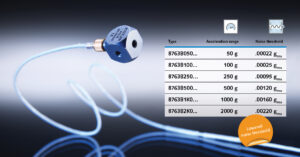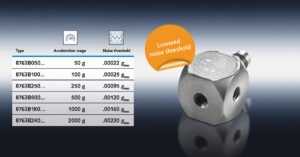Sensor specialist Kistler says it has updated its 8763B triaxial accelerometer. According to the company, the sensor’s noise thresholds are now significantly lower for all ranges. Thanks to improved testing procedures, thresholds are up to 58% lower, which allows for more accurate measurements in micro-vibration monitoring. Manufacturing process improvements have also reportedly led to shorter manufacturing times.
Because micro-vibrations occur in the micro-g range, a highly sensitive measuring chain with very low noise is required for such applications. The IEPE (Integrated Electronics Piezoelectric) 8763B triaxial accelerometer is the most common Kistler sensor used for these measurements and permits vibration monitoring in three mutually perpendicular axes.
The measuring threshold determines the smallest-possible level of vibrations that can be reliably picked up by the sensor. In 2021, Kistler improved the sensor’s noise threshold for the 50-g range. More efficient testing procedures and large investments in Kistler’s facilities have now led to further improvements. The 8763B now features a significantly lower noise threshold for all its ranges: not only does it achieve a 58% lower noise threshold for the 100g range but it also has a 37% reduction for the 250g range, 52% for the 500g range, 54% for the 1,000g range and 51% for the sensor’s highest range of 2,000g. Kistler states that with these improvements, the sensor is particularly well suited to applications such modal analysis, frequency response measurement and e-motor testing.
The 8763B sensor provides a wide frequency response in each orthogonal axis, making it useful for dynamic vibration measurements, especially on lightweight structures. Other features include a lightweight hermetic titanium housing and high immunity to base strain thanks to the integration of shear element technology.
Sensors in the 8763B family can be installed on test objects by either adhesive mounting or flexible studs thanks to three 5-40 threaded holes, making it possible to fully utilize each mounting side of the cube design and ensuring reliable mounting for the calibration of each axis.





